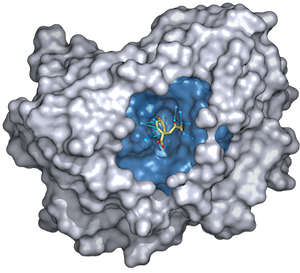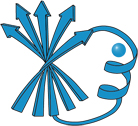Protein Structural Analysis Laboratory Software
Michigan State University

Software

Note that software developed by our group is now available for download from GitHub
Consolv: a tool for predicting whether water molecules bound to the surface of a protein are likely to be conserved or displaced in other structures of the protein, especially upon ligand binding. See Raymer et al. (1997) "Predicting Conserved Water-Mediated and Polar Ligand Interactions in Proteins Using a K-nearest-neighbors Genetic Algorithm" on the Publications page.
Hbind: Calculates hydrogen-bond interaction tables for protein-small molecule complexes, based on protein PDB and protonated ligand MOL2 structure input. See Raschka et al. (2018) "Protein-ligand interfaces are polarized: Discovery of a strong trend for intermolecular hydrogen bonds to favor donors on the protein side with implications for predicting and designing ligand complexes" on the Publications page.
HbindViz: Generates a script to visualize protein-ligand H-bonds from an Hbind interaction table (see separate Hbind module) for display by PyMOL. See Raschka et al. (2018) "Protein-ligand interfaces are polarized: Discovery of a strong trend for intermolecular hydrogen bonds to favor donors on the protein side with implications for predicting and designing ligand complexes" on the Publications page.
Predicting Activity by Machine Learning: Protocols for identifying biological activity determinants in the structural and chemical features of a set of small molecules that have been assayed. Useful for structure-activity relationship analysis of compounds identified by Screenlamp and other screening approaches. See Raschka et al. (2018) "Automated Inference of Chemical Discriminants of Biological Activity" on the Publications page.
ProFlex: MSU ProFlex (formerly called FIRST) predicts the rigid and flexible regions in a protein structure, given a Protein Data Bank (PDB) file including polar hydrogen atoms. See Jacobs et al. (2001) "Protein Flexibility Predictions Using Graph Theory" on the Publications page.
Protein-Alignment-Tool: BRAT shows key residue (e.g., ligand-binding or allosteric pathway) correspondences between sequence-divergent homologs aligned by structural superposition. BAT displays residues and their numeric properties (from the B-value column) of PDB structures, given their structural superposition. See Bemister-Buffington et al. (2020) on the Publications page.
Protein Recognition Index: Calculates the Protein Recognition Index (PRI) value, measuring the similarity between intermolecular H-bonding features in a given protein-ligand complex (predicted or designed) and the H-bond trends observed in diverse protein-ligand crystallographic complexes. See Raschka et al. (2018) "Protein-ligand interfaces are polarized: Discovery of a strong trend for intermolecular hydrogen bonds to favor donors on the protein side with implications for predicting and designing ligand complexes" on the Publications page.
Screenlamp: A toolkit for facilitating hypothesis-driven, ligand-based screening of large molecular libraries. See Raschka et al. (2018) "Enabling the hypothesis-driven prioritization of ligand candidates in big databases: Screenlamp and its application to GPCR inhibitor discovery for invasive species control" on the Publications page.
Sequery: Searches the sequences of the protein structures in the Protein Data Bank (PDB) for a particular pattern of residues, including exact matches, matrix calculated substitutions, and user-defined substitutions. See Craig et al. (1998) "The Role of Structure in Antibody Cross-Reactivity Between Peptides and Folded Proteins" on the Publications page.
SimSite3D: Designed to quickly search a database of three dimensional structures with known ligand binding sites in Protein Data Bank format, to identify which sites in the database have significant steric and chemical similarity to a query binding site.
SiteInterlock: A toolkit for predicting protein-small molecule interactions based on interfacial rigidification. See Raschka et al. (2016) "Detecting the Native Ligand Orientation by Interfacial Rigidity: SiteInterlock" on the Publications page.
SLIDE: A computational screening and flexible docking tool designed to discover ligands with good steric and chemical complementarity to the known three-dimensional structure of a protein's binding site. See Zavodszky et al. (2002) "Distilling the Essential Features of a Protein Surface for Improving Protein-Ligand Docking, Scoring, and Virtual Screening" on the Publications page.
SpeciFlex: A tool to define the volumes sampled by atoms in MD trajectories or across multiple crystal or NMR structures, or to compute difference-volumes from two trajectories (or compare the difference in volumes sampled by two panels of ensembles of crystallographic or NMR conformations).
SSA: The Superpositional Structure Assignment (SSA) software automates the assignment of the secondary structure of a peptide from its atomic coordinates in PDB format based on their superposition with sequences of ideal secondary structure. See Craig et al. (1998) "The Role of Structure in Antibody Cross-Reactivity Between Peptides and Folded Proteins" on the Publications page.
WatCH: Calculates and analyzes conserved water molecule binding sites among a series of crystallographic structures of the same protein using heirarchical cluster analysis. See Sanschagrin et al. (1998) "Cluster Analysis of Consensus Water Sites in Thrombin and Trypsin Shows Conservation Between Serine Proteases and Contributions to Ligand Specificity" on the publications page.
